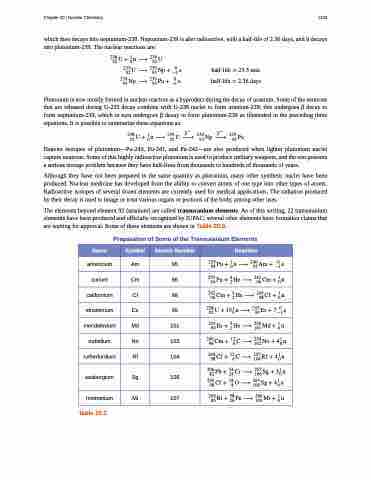Page 1133 - Chemistry--atom first
P. 1133
Chapter 20 | Nuclear Chemistry 1123
which then decays into neptunium-239. Neptunium-239 is also radioactive, with a half-life of 2.36 days, and it decays into plutonium-239. The nuclear reactions are:
����� �� � ���� �� � ��
����������� �� �� �� ��
������������ �� �� �� ��
����������������� ������������������
Plutonium is now mostly formed in nuclear reactors as a byproduct during the decay of uranium. Some of the neutrons that are released during U-235 decay combine with U-238 nuclei to form uranium-239; this undergoes β decay to form neptunium-239, which in turn undergoes β decay to form plutonium-239 as illustrated in the preceding three equations. It is possible to summarize these equations as:
��� � ��� �� ��� �� ��� ���� �� � ��� ���� ���� ���� ����
Heavier isotopes of plutonium—Pu-240, Pu-241, and Pu-242—are also produced when lighter plutonium nuclei capture neutrons. Some of this highly radioactive plutonium is used to produce military weapons, and the rest presents a serious storage problem because they have half-lives from thousands to hundreds of thousands of years.
Although they have not been prepared in the same quantity as plutonium, many other synthetic nuclei have been produced. Nuclear medicine has developed from the ability to convert atoms of one type into other types of atoms. Radioactive isotopes of several dozen elements are currently used for medical applications. The radiation produced by their decay is used to image or treat various organs or portions of the body, among other uses.
The elements beyond element 92 (uranium) are called transuranium elements. As of this writing, 22 transuranium elements have been produced and officially recognized by IUPAC; several other elements have formation claims that are waiting for approval. Some of these elements are shown in Table 20.3.
Preparation of Some of the Transuranium Elements
Name
Symbol
Atomic Number
Reaction
americium
Am
95
������ �� � ������ � � �� � �� ��
curium
Cm
96
������ ��� � ������ �� �� � �� �
californium
Cf
98
��� �� � � �� � ��� �� � � � �� � �� �
einsteinium
Es
99
��� � � ��� � � ��� �� � � � � �� � �� ��
mendelevium
Md
101
������ ��� � ������ �� �� � ��� �
nobelium
No
102
��� �� � �� � � ��� �� � �� � �� � ��� �
rutherfordium
Rf
104
��� �� � �� � � ��� �� � �� � �� � ��� �
seaborgium
Sg
106
������ ���� � ��������� �� �� ��� �
��� �� � �� � � ��� �� � �� � �� � ��� �
meitnerium
Mt
107
������ ���� � ������ �� �� �� ��� �
Table 20.3


